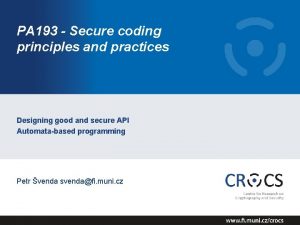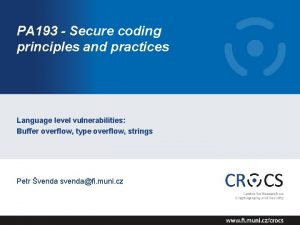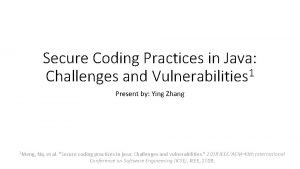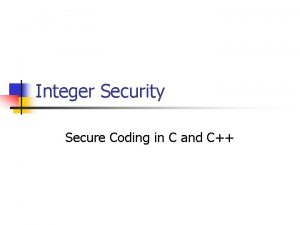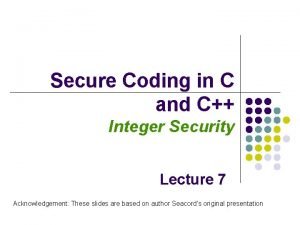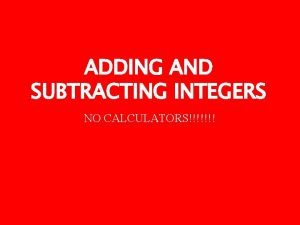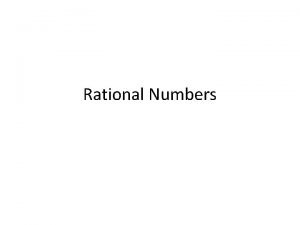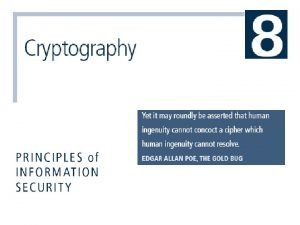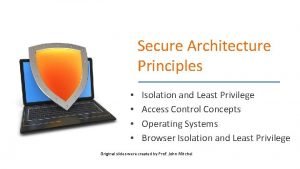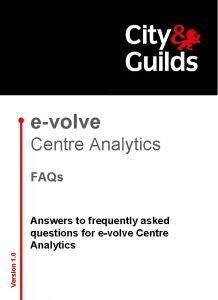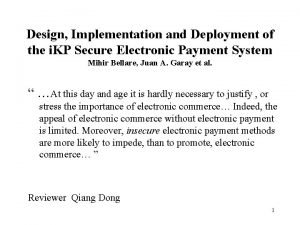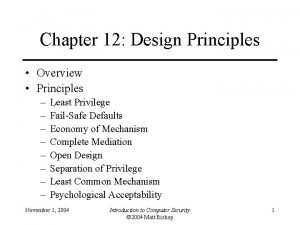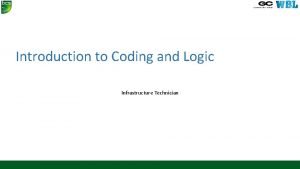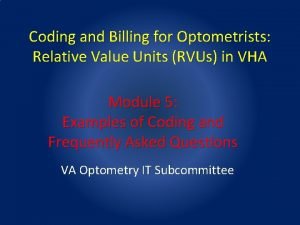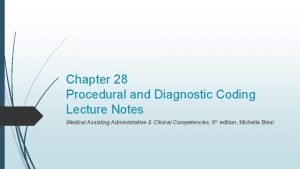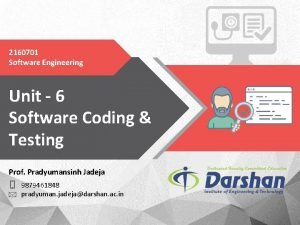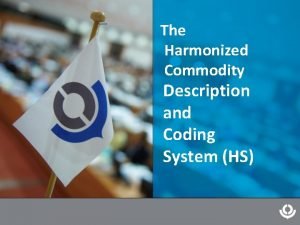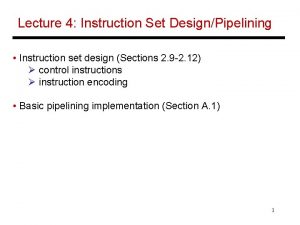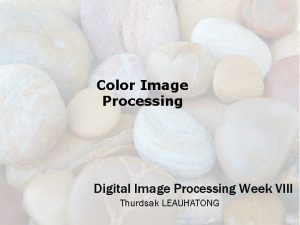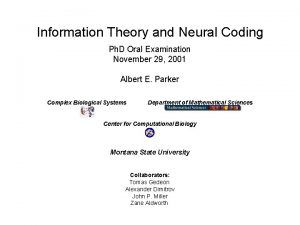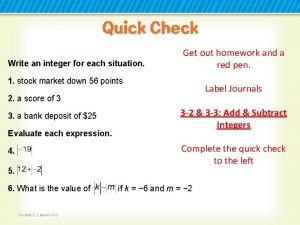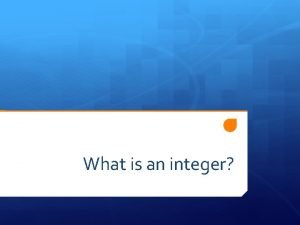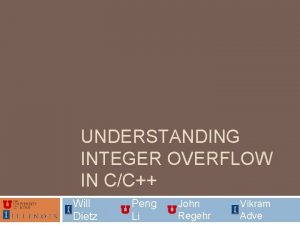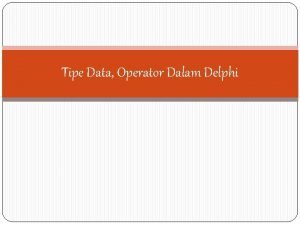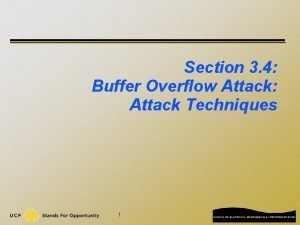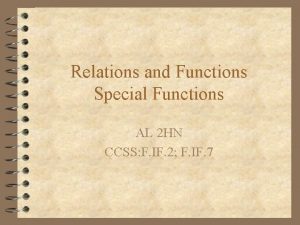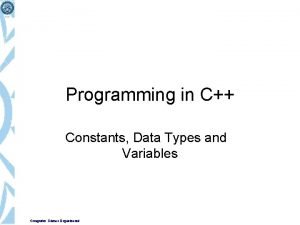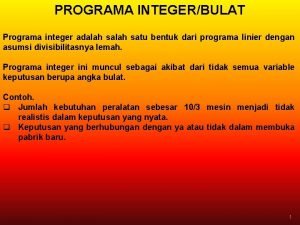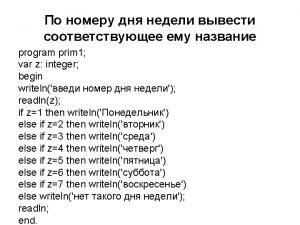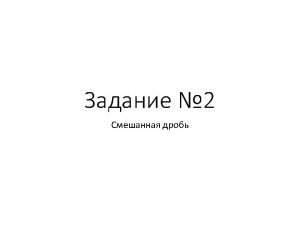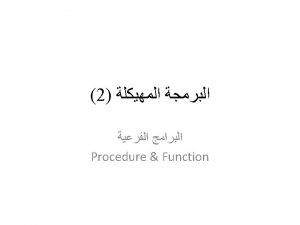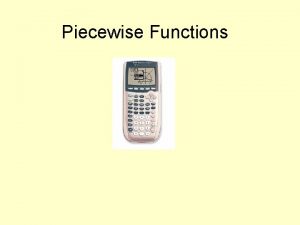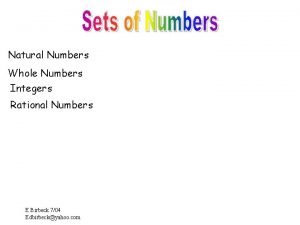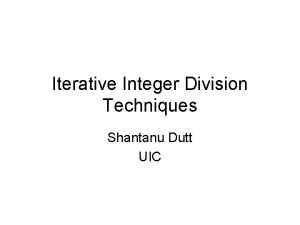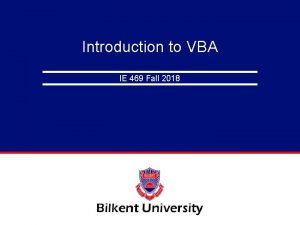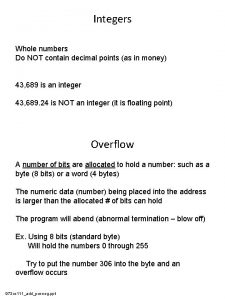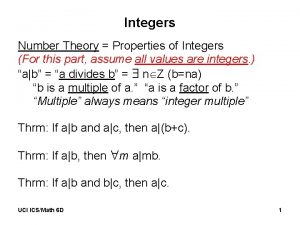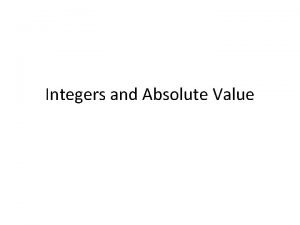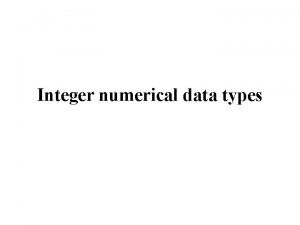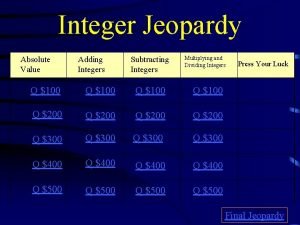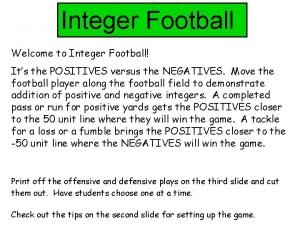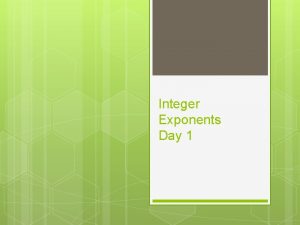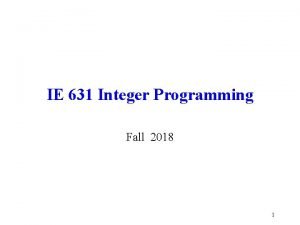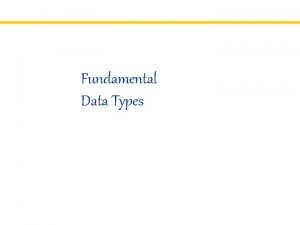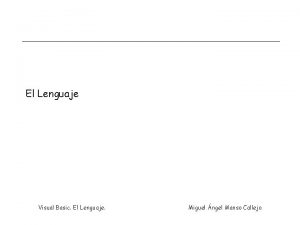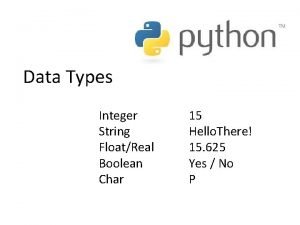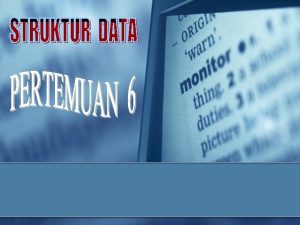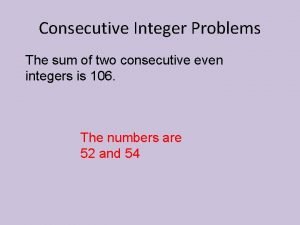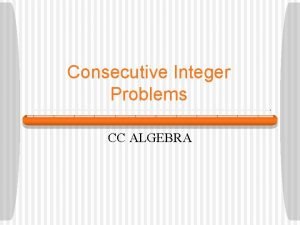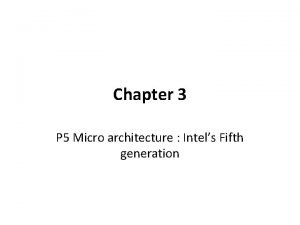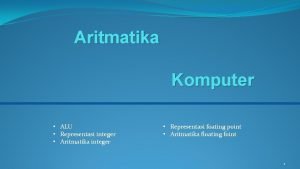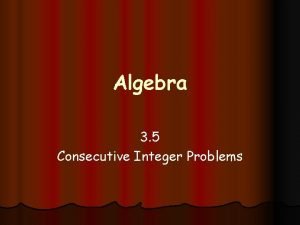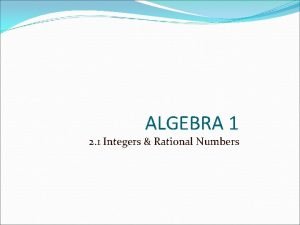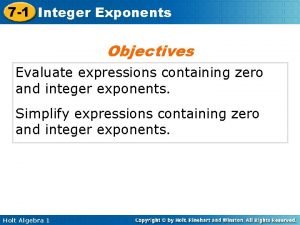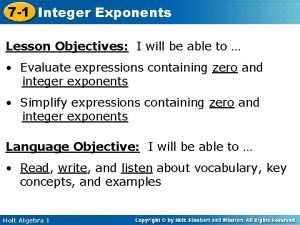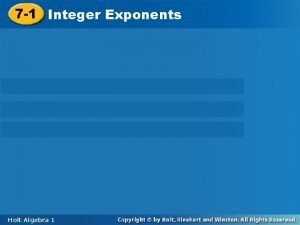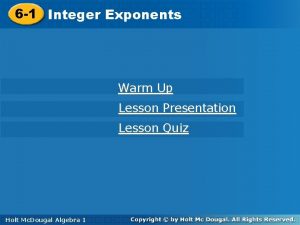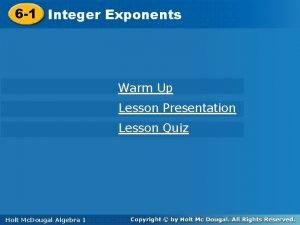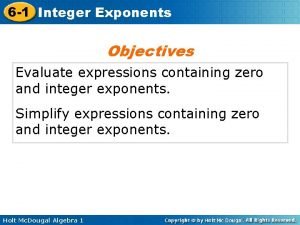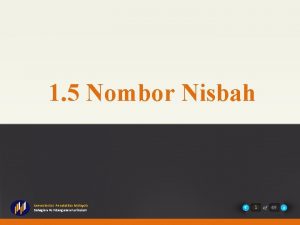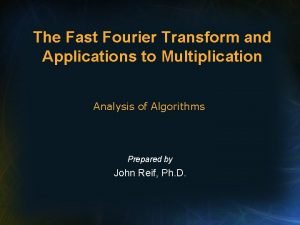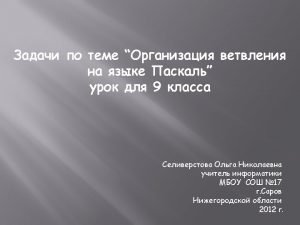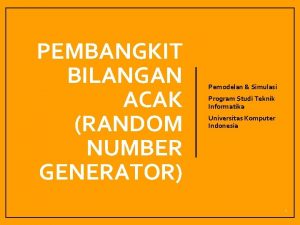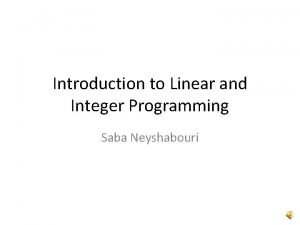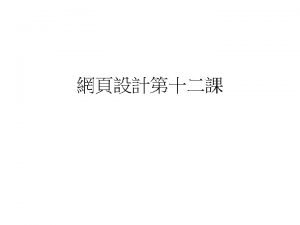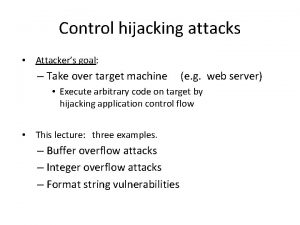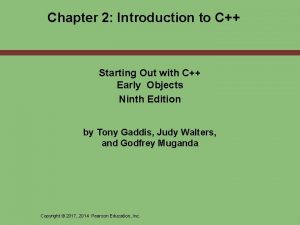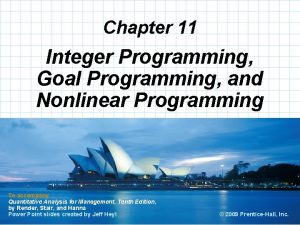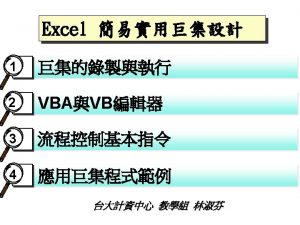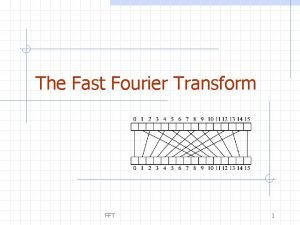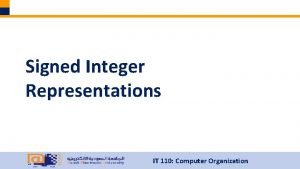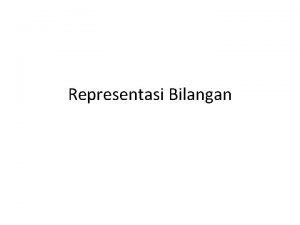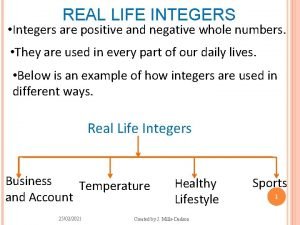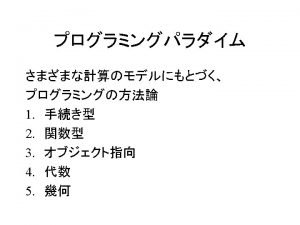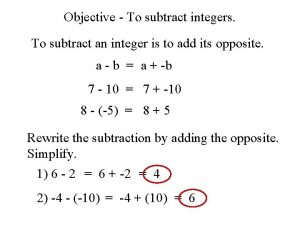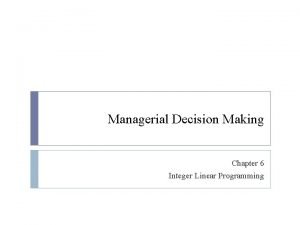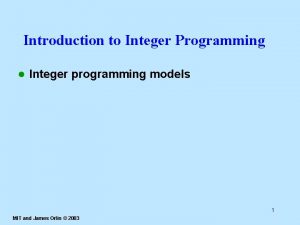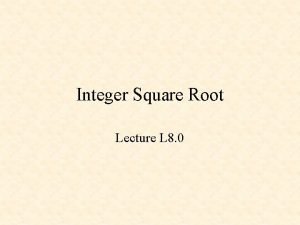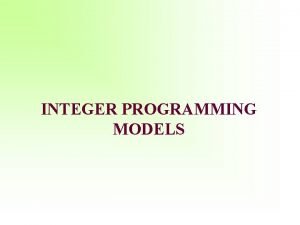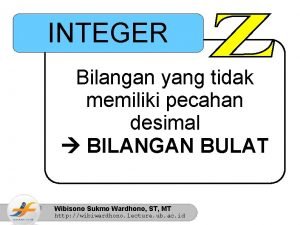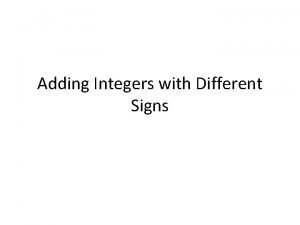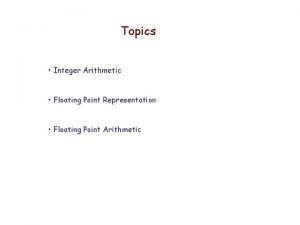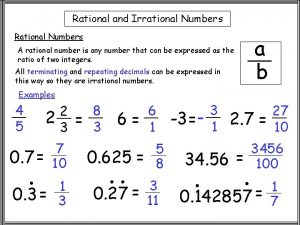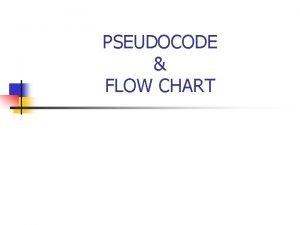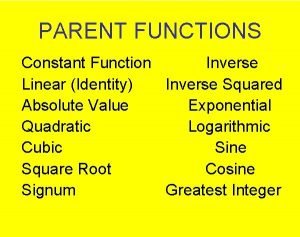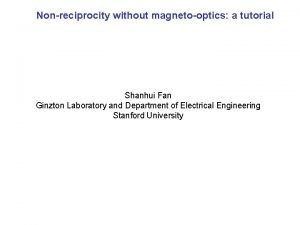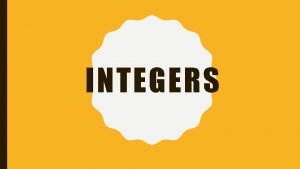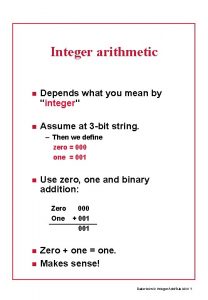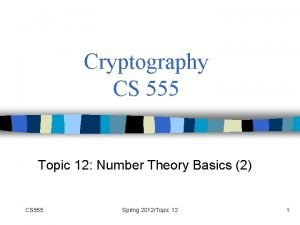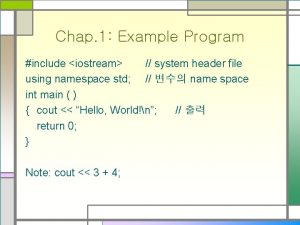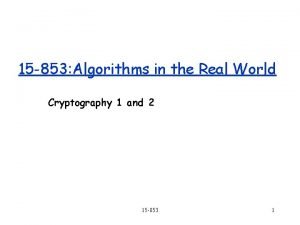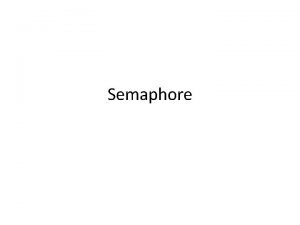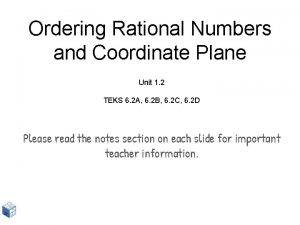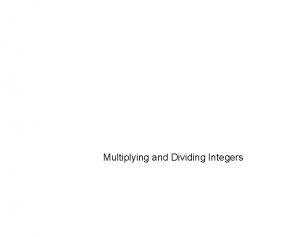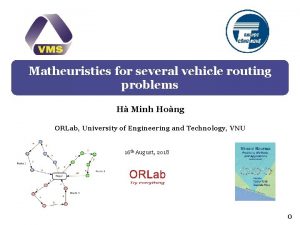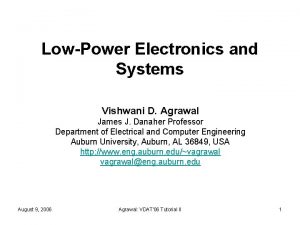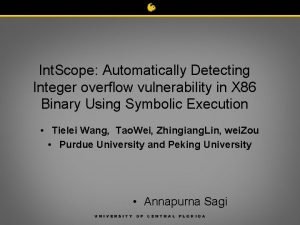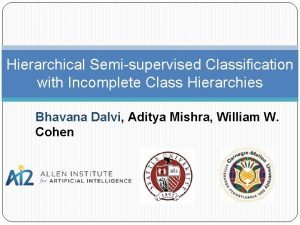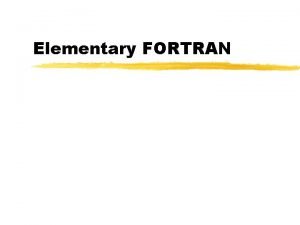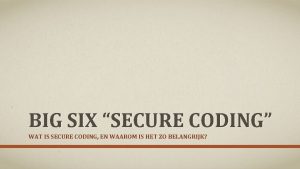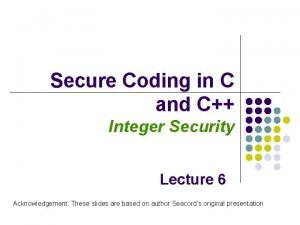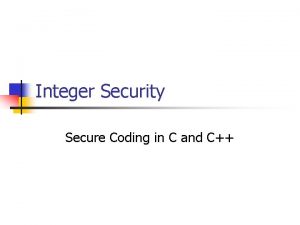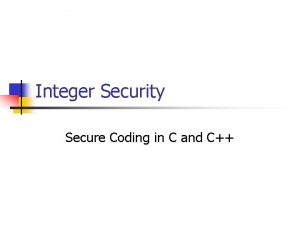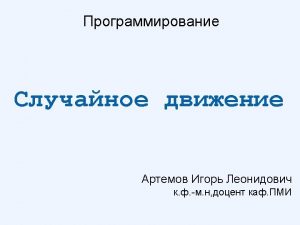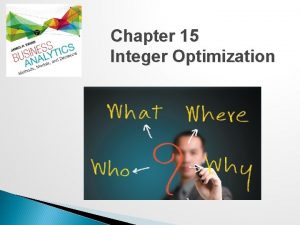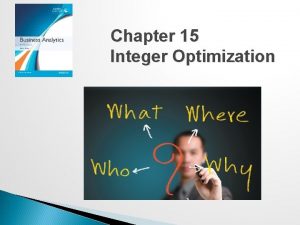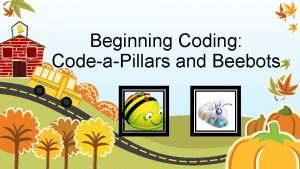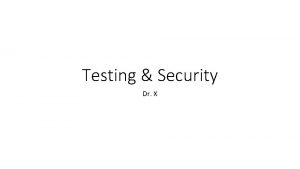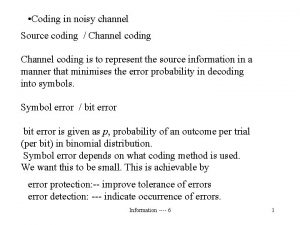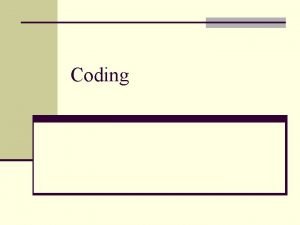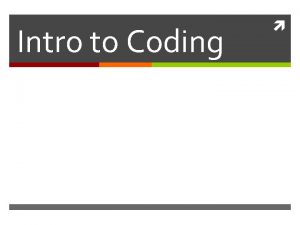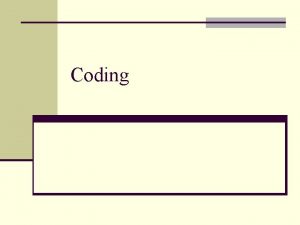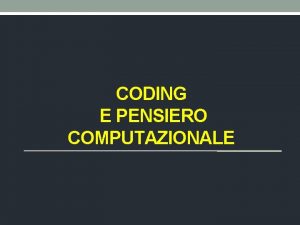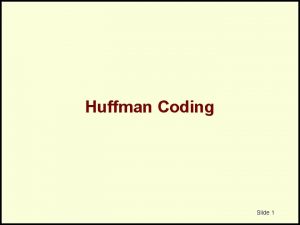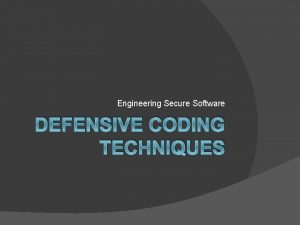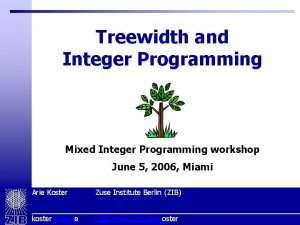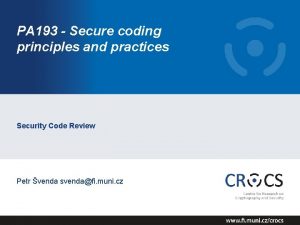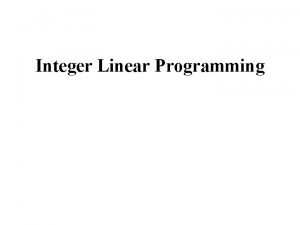Integer Security Secure Coding in C and C
















































































![Signed Integer Division mov eax, dword ptr [si_dividend] cdq idiv eax, dword ptr [si_divisor] Signed Integer Division mov eax, dword ptr [si_dividend] cdq idiv eax, dword ptr [si_divisor]](https://slidetodoc.com/presentation_image_h/8c08f2d8b3e60d875886692f3b07787c/image-81.jpg)
![Unsigned Integer Division ui_quotient = ui 1_dividend / ui_divisor; mov eax, dword ptr [ui_dividend] Unsigned Integer Division ui_quotient = ui 1_dividend / ui_divisor; mov eax, dword ptr [ui_dividend]](https://slidetodoc.com/presentation_image_h/8c08f2d8b3e60d875886692f3b07787c/image-82.jpg)



































































- Slides: 149

Integer Security Secure Coding in C and C++

Integers n n Integers represent a growing and underestimated source of vulnerabilities in C and C++ programs. Integer range checking has not been systematically applied in the development of most C and C++ software. n n n security flaws involving integers exist a portion of these are likely to be vulnerabilities A software vulnerability may result when a program evaluates an integer to an unexpected value.

Integer Security Example 1. 2. 3. 4. 5. 6. 7. 8. int main(int argc, char *argv[]) { unsigned short int total; total = strlen(argv[1])+ strlen(argv[2])+1; char *buff = (char *)malloc(total); strcpy(buff, argv[1]); strcat(buff, argv[2]); }

Integer Representation Signed-magnitude n One’s complement n Two’s complement n These integer representations vary in how they represent negative numbers n

Signed-magnitude Representation n Uses the high-order bit to indicate the sign n 0 for positive 1 for negative remaining low-order bits indicate the magnitude of the value Signed magnitude representation of +41 and 41 n

One’s Complement n One’s complement replaced signed magnitude because the circuitry was too complicated. n Negative numbers are represented in one’s complement form by complementing each bit even the sign bit is reversed 0 0 1 1 1 0 each 1 is replaced with a 0 each 0 is replaced with a 1

Two’s Complement The two’s complement form of a negative integer is created by adding one to the one’s complement representation. n 0 0 1 0 1 0 0 1 1 1 0 + 1 = 1 1 0 1 1 1 Two’s complement representation has a single (positive) value for zero. n. The sign is represented by the most significant bit. n. The notation for positive integers is identical to their signed-magnitude representations. n

Signed and Unsigned Types Integers in C and C++ are either signed or unsigned. n. For each signed type there is an equivalent unsigned type. n

Signed Integers Signed integers are used to represent positive and negative values. n On a computer using two’s complement arithmetic, a signed integer ranges from -2 n-1 through 2 n-1 -1. n

Signed Integer Representation

Unsigned Integers Unsigned integer values range from zero to a maximum that depends on the size of the type. n This maximum value can be calculated as 2 n-1, where n is the number of bits used to represent the unsigned type. n

Unsigned Integers Unsigned integer values range from zero to a maximum that depends on the size of the type. n. This maximum value can be calculated as 2 n-1, where n is the number of bits used to represent the unsigned type. n. For each signed integer type, there is a corresponding unsigned integer type. n

Unsigned Integer Representation two’s complement

Integer Types There are two broad categories of integer types: standard and extended. n n n standard integer types include all the well-known integer types. extended integer types are defined in the C 99 standard to specify integer types with fixed constraints.

Standard Types Standard integers include the following types, in non-decreasing length order n signed char n short int n long int n

Extended Integer Types Extended integer types are implementation defined and include the following types n int#_t, uint#_t where # is an exact width n int_least#_t, uint_least#_t where # is a width of at least that value n int_fast#_t, uint_fast#_t where # is a width of at least that value for fastest integer types n intptr_t, uintptr_t are integer types wide enough to hold pointers to objects n

Platform-Specific Integer Types Vendors often define platform-specific integer types. n. The Microsoft Windows API defines a large number of integer types n n n n n __int 8, __int 16, __int 32, __int 64 ATOM BOOLEAN, BOOL BYTE CHAR DWORD, DWORDLONG, DWORD 32, DWORD 64 WORD INT, INT 32, INT 64 LONG, LONG 32, LONG 64

Integer Ranges Minimum and maximum values for an integer type depend on n n the type’s representation signedness number of allocated bits The C 99 standard sets minimum requirements for these ranges. n

Example Integer Ranges

Integer Conversions Type conversions occur explicitly in C and C++ as the result of a cast or implicitly as required by an operation. n Conversions can lead to lost or misinterpreted data. n Implicit conversions are a consequence of the C language ability to perform operations on mixed types. n C 99 rules define how C compilers handle conversions n n integer promotions integer conversion rank usual arithmetic conversions

Integer Promotions Integer types smaller than int are promoted when an operation is performed on them. n. If all values of the original type can be represented as an int n n n the value of the smaller type is converted to int otherwise, it is converted to unsigned int. Integer promotions are applied as part of the usual arithmetic conversions to n n certain argument expressions operands of the unary +, -, and ~ operators operands of the shift operators

Integer Promotion Example Integer promotions require the promotion of each variable (c 1 and c 2) to int size n n char c 1, c 2; c 1 = c 1 + c 2; The two ints are added and the sum truncated to fit into the char type. n Integer promotions avoid arithmetic errors from the overflow of intermediate n

Implicit Conversions The sum of c 1 and c 2 exceeds the 1. char cresult, c 1, c 2, c 3; maximum size of signed char n 2. c 1 = 100; However, c 1, and c 3 are each converted to integers and the overall n 3. c 2 = 90; expression is successfully evaluated. n 4. c 3 = -120; n 5. cresult = c 1 + c 2 + c 3; n The sum is truncated and stored in cresult without a loss of data The value of c 1 is added to the value of c 2.

Integer Conversion Rank Every integer type has an integer conversion rank that determines how conversions are performed. n

Integer Conversion Rank Rules No two signed integer types have the same rank, even if they have the same representation. n The rank of a signed integer type is > the rank of any signed integer type with less precision. n The rank of long int is > the rank of long int, which is > the rank of short int, which is > the rank of signed char. n The rank of any unsigned integer type is equal to the rank of the corresponding signed integer type. n

Unsigned Integer Conversions of smaller unsigned integer types to larger unsigned integer types is n n n always safe typically accomplished by zero-extending the value When a larger unsigned integer is converted to a smaller unsigned integer type the n n n larger value is truncated low-order bits are preserved

Unsigned Integer Conversions When unsigned integer types are converted to the corresponding signed integer type n the bit pattern is preserved so no data is lost n the high-order bit becomes the sign bit n If the sign bit is set, both the sign and magnitude of the value changes. n

From unsigned To Method char Preserve bit pattern; high-order bit becomes sign bit char short Zero-extend char long Zero-extend char unsigned short Zero-extend char unsigned long Zero-extend short char Preserve low-order byte short Preserve bit pattern; high-order bit becomes sign bit short long Zero-extend short unsigned char Preserve low-order byte long short Preserve low-order word long Preserve bit pattern; high-order bit becomes sign bit long unsigned char Preserve low-order byte long unsigned short Preserve low-order word Key: Lost data Misinterpreted data

Signed Integer Conversions When a signed integer is converted to an unsigned integer of equal or greater size and the value of the signed integer is not negative n the value is unchanged n the signed integer is sign-extended n A signed integer is converted to a shorter signed integer by truncating the high-order bits. n

Signed Integer Conversions 2 n When signed integers are converted to unsigned integers n n bit pattern is preserved—no lost data high-order bit loses its function as a sign bit If the value of the signed integer is not negative, the value is unchanged. n If the value is negative, the resulting unsigned value is evaluated as a large, signed integer. n

From To Method char short Sign-extend char long Sign-extend char unsigned char Preserve pattern; high-order bit loses function as sign bit char unsigned short Sign-extend to short; convert short to unsigned short char unsigned long Sign-extend to long; convert long to unsigned long short char Preserve low-order byte short long Sign-extend short unsigned char Preserve low-order byte short unsigned short Preserve bit pattern; high-order bit loses function as sign bit short unsigned long Sign-extend to long; convert long to unsigned long char Preserve low-order byte long short Preserve low-order word long unsigned char Preserve low-order byte long unsigned short Preserve low-order word long unsigned long Preserve pattern; high-order bit loses function as sign bit Key: Lost data Misinterpreted data

Signed Integer Conversion Example 1. unsigned int l = ULONG_MAX; The value of c is 2. char c = -1; compared to the value of l. 3. if (c == l) { 4. printf("-1 = 4, 294, 967, 295? n"); 5. } Because of integer promotions, c is converted to an unsigned integer with a value of 0 x. FFFF or 4, 294, 967, 295

Signed/Unsigned Characters n The type char can be signed or unsigned. When a signed char with its high bit set is saved in an integer, the result is a negative number. n Use unsigned char for buffers, pointers, and casts when dealing with character data that may have values greater than 127 (0 x 7 f). n

Usual Arithmetic Conversions 1. 2. 3. 4. 5. If both operands have the same type no conversion is needed. If both operands are of the same integer type (signed or unsigned), the operand with the type of lesser integer conversion rank is converted to the type of the operand with greater rank. If the operand that has unsigned integer type has rank >= to the rank of the type of the other operand, the operand with signed integer type is converted to the type of the operand with unsigned integer type. If the type of the operand with signed integer type can represent all of the values of the type of the operand with unsigned integer type, the operand with unsigned integer type is converted to the type of the operand with signed integer type. Otherwise, both operands are converted to the unsigned integer type corresponding to the type of the operand with signed integer type.

Integer Error Conditions 1 Integer operations can resolve to unexpected values as a result of an n n overflow sign error truncation

Overflow An integer overflow occurs when an integer is increased beyond its maximum value or decreased beyond its minimum value. n Overflows can be signed or unsigned n A signed overflow occurs when a value is carried over to the sign bit An unsigned overflow occurs when the underlying representation can no longer represent a value

Overflow Examples 1 n n 1. int i; 2. unsigned int j; 3. i = INT_MAX; // 2, 147, 483, 647 i=-2, 147, 483, 648 n 4. i++; n 5. printf("i = %dn", i); n 6. j = UINT_MAX; // 4, 294, 967, 295; n 7. j++; j = 0 n 8. printf("j = %un", j); n

Overflow Examples 2 9. i = INT_MIN; // -2, 147, 483, 648; i=2, 147, 483, 647 n 10. i--; n 11. printf("i = %dn", i); n 12. j = 0; n 13. j--; j = 4, 294, 967, 295 n 14. printf("j = %un", j); n

Truncation Errors n Truncation errors occur when n n an integer is converted to a smaller integer type and the value of the original integer is outside the range of the smaller type Low-order bits of the original value are preserved and the high-order bits are lost. n

Truncation Error Example 1. char cresult, c 1, c 2, c 3; n 2. c 1 = 100; Adding c 1 and c 2 exceeds the max size n 3. c 2 = 90; of signed char (+127) n 4. cresult = c 1 + c 2; n Truncation occurs when the value is assigned to a type that is too small to represent the resulting value Integers smaller than int are promoted to int or unsigned int before being operated on

Sign Errors n Converting an unsigned integer to a signed integer of n n n Equal size - preserve bit pattern; high-order bit becomes sign bit Greater size - the value is zero-extended then converted Lesser size - preserve low-order bits If the high-order bit of the unsigned integer is Not set - the value is unchanged Set - results in a negative value

Sign Errors n Converting a signed integer to an unsigned integer of n n Equal size - bit pattern of the original integer is preserved Greater size - the value is sign-extended then converted Lesser size - preserve low-order bits If the value of the signed integer is n n Not negative - the value is unchanged Negative - the result is typically a large positive value

Sign Error Example 1. 2. 3. 4. int i = -3; unsigned short u; u = i; printf("u = %hun", u); Implicit conversion to smaller unsigned integer There are sufficient bits to represent the value so no truncation occurs. The two’s complement representation is interpreted as a large signed value, however, so u = 65533

Error Detection n Integer errors can be detected n n n By the hardware Before they occur based on preconditions After they occur based on postconditions

Integer Operations n n Integer operations can result in errors and unexpected value. Unexpected integer values can cause n n n unexpected program behavior security vulnerabilities Most integer operations can result in exceptional conditions.

Integer Addition n Addition can be used to add two arithmetic operands or a pointer and an integer. If both operands are of arithmetic type, the usual arithmetic conversions are performed on them. Integer addition can result in an overflow if the sum cannot be represented in the number allocated bits

IA-32 Add Instruction n IA-32 add instruction n n n add destination, source Adds the 1 st (destination) op to the 2 nd (source) op Stores the result in the destination operand Destination operand can be a register or memory location Source operand can be an immediate, register, or memory location Signed and unsigned overflow conditions are detected and reported.

IA-32 Add Instruction n add ax, bx n n n adds the 16 -bit bx register to the 16 -bit ax register leaves the sum in the ax register The add instruction sets flags in the flags register n n overflow flag indicates signed arithmetic overflow carry flag indicates unsigned arithmetic overflow

Layout of the Flags Register 15 Overflow Direction Interrupt Sign Zero Auxiliary Carry Parity Carry 0

Interpretation of Flags n n There are no distinctions between the addition of signed and unsigned integers at the machine level. Overflow and carry flags must be interpreted in context.

Adding Signed/Unsigned char When adding two signed chars the values are sign extended sc 1 + sc 2 1. movsx eax, byte ptr [sc 1] 2. movsx ecx, byte ptr [sc 2] 3. add eax, ecx When adding two unsigned chars the values are zero extended to avoid changing the magnitude uc 1 + uc 2 4. movzx eax, byte ptr [uc 1] 5. movzx ecx, byte ptr [uc 2] 6. add eax, ecx

Adding Signed/Unsigned int Adding two unsigned int values ui 1 + ui 2 7. mov eax, dword ptr [ui 1] 8. add eax, dword ptr [ui 2] Identical code is generated for signed int values

Adding signed long int The add instruction adds the low-order 32 bits sll 1 + sll 2 n 9. mov eax, dword ptr [sll 1] n 10. add eax, dword ptr [sll 2] n 11. mov ecx, dword ptr [ebp-98 h] n 12. adc ecx, dword ptr [ebp 0 A 8 h] n The adc instruction adds the high-order 32 bits and the value of the carry bit

Unsigned Overflow Detection The carry flag denotes an unsigned arithmetic overflow. Unsigned overflows can be detected using the jc instruction (jump if carry) jnc instruction (jump if not carry) Conditional jump instructions are placed after the add instruction in the 32 -bit case adc instruction in the 64 -bit case

Signed Overflow Detection The overflow flag denotes a signed arithmetic overflow Signed overflows can be detected using the jo instruction (jump if overflow) jno instruction (jump if not overflow) Conditional jump instructions are placed after the add instruction in the 32 -bit case adc instruction in the 64 -bit case

Precondition Addition of unsigned integers can result in an integer overflow if the sum of the left-hand side (LHS) and right-hand side (RHS) of an addition operation is greater than UINT_MAX for addition of unsigned int type ULLONG_MAX for addition of unsigned long type

Precondition Example Overflow occurs when A and B are unsigned int and A + B > UINT_MAX To prevent the test from overflowing, code this test as A > UINT_MAX – B Overflow also occurs when A and B are long int and A + B > ULLONG_MAX

Addition of signed integers is more complicated: n LHS RHS Exceptional Condition Positive Negative Overflow if INT_MAX – LHS < RHS None possible Negative Positive Negative None possible Overflow if LHS < INT_MIN – RHS

Postcondition Perform the addition and then evaluate the results of the operation. Example: Let sum = lhs + rhs. If lhs is non-negative and sum < rhs, an overflow has occurred. If lhs is negative and sum > rhs, an overflow has occurred. In all other cases, the addition operation succeeds without overflow. For unsigned integers, if the sum is smaller than either operand, an overflow has occurred.

Integer Subtraction The IA-32 instruction set has sub (subtract) sbb (subtract with borrow). The sub and sbb instructions set the overflow and carry flags to indicate an overflow in the signed or unsigned result.

sub Instruction Subtracts the 2 nd (source) operand from the 1 st (destination) operand Stores the result in the destination operand The destination operand can be a register memory location The source operand can be a(n) immediate register memory location

sbb Instruction The sbb instruction is executed as part of a multi-byte or multi-word subtraction. The sbb instruction adds the 2 nd (source) operand the carry flag and subtracts the result from the 1 st (destination) operand The result of the subtraction is stored in the destination operand. The carry flag represents a borrow from a previous subtraction.

signed long int Sub The sub instruction subtracts the low-order 32 bits sll 1 - sll 2 1. mov eax, dword ptr [sll 1] 2. sub eax, dword ptr [sll 2] 3. mov ecx, dword ptr [ebp-0 E 0 h] 4. sbb ecx, dword ptr [ebp-0 F 0 h] The sbb instruction subtracts the low-order 32 bits NOTE: Assembly Code Generated by Visual C++ for Windows 2000

Precondition To test for overflow for unsigned integers LHS < RHS. Exceptional conditions cannot occur for signed integers of the same sign. For signed integers of mixed signs If LHS is positive and RHS is negative, check that the lhs > INT_MAX + rhs If LHS is non-negative and RHS is negative, check that lhs < INT_MAX + rhs For example, 0 – INT_MIN causes an overflow condition because the result of the operation is one greater than the maximum representation possible.

Postcondition To test for overflow of signed integers, let difference = lhs - rhs and apply the following n n If rhs is non-negative and difference > lhs an overflow has occurred If rhs is negative and difference < lhs an overflow has occurred In all other cases no overflow occurs For unsigned integers an overflow occurs if difference > lhs. n

Integer Multiplication is prone to overflow errors because relatively small operands can overflow One solution is to allocate storage for the product that is twice the size of the larger of the two operands.

Multiplication Instructions The IA-32 instruction set includes a mul (unsigned multiply) instruction imul (signed multiply) instruction The mul instruction performs an unsigned multiplication of the 1 st (destination) operand the 2 nd (source) operand stores the result in the destination operand.

Unsigned Multiplication Pseudo-code Product of 8 -bit 1. if (Operand. Size == 8) { operands are stored in 16 -bit destination registers 2. AX = AL * SRC; 3. else { Product of 16 -bit operands 4. if (Operand. Size == 16) {are stored in 32 -bit destination registers 5. DX: AX = AX * SRC; 6. } 7. else { // Operand. Size == 32 8. EDX: EAX = EAX * SRC; 9. } 10. } Product of 32 -bit operands are stored in 64 -bit destination registers

Carry and Overflow Flags If the high-order bits are required to represent the product of the two operands, the carry and overflow flags are set If the high-order bits are not required (that is, they are equal to zero), the carry and overflow flags are cleared

Signed and Unsigned Character Multiplication (Visual C++) sc_product = sc 1 * sc 2; 1. movsx eax, byte ptr [sc 1] 2. movsx ecx, byte ptr [sc 2] 3. imul eax, ecx 4. mov byte ptr [sc_product], al uc_product = uc 1 * uc 2; 5. movzx eax, byte ptr [uc 1] 6. movzx ecx, byte ptr [uc 2] 7. imul eax, ecx 8. mov byte ptr [uc_product], al

Signed and Unsigned Integer Multiplication (Visual C++) si_product = si 1 * si 2; ui_product = ui 1 * ui 2; 9. mov eax, dword ptr [ui 1] 10. imul eax, dword ptr [ui 2] 11. mov dword ptr [ui_product], eax NOTE: Assembly code generated by Visual C++

Signed and Unsigned Character Multiplication (g++) g++ uses the byte form of the mul instruction for char integers, regardless of whether the type is signed or unsigned sc_product = sc 1 * sc 2; uc_product = uc 1 * uc 2; 1. movb -10(%ebp), %al 2. mulb -9(%ebp) 3. movb %al, -11(%ebp)

Signed and Unsigned Integer Multiplication (g++) g++ uses imul instruction for word length integers regardless of whether the type is signed or unsigned si_product = si 1 * si 2; ui_product = ui 1 * ui 2; 4. movl -20(%ebp), %eax 5. imull -24(%ebp), %eax 6. movl %eax, -28(%ebp)

Precondition To prevent an overflow when multiplying unsigned integers, check that A * B > MAX_INT can be tested using the expression A > MAX_INT / B Division, however, is an expensive operation

Postcondition Cast both operands to the next larger size and then multiply. For unsigned integers check high-order bits in the next larger integer if any are set, throw an error. For signed integers all zeros or all ones in the high-order bits and the sign bit on the low-order bit indicate no overflow.

Upcast Example void* Alloc. Blocks(size_t c. Blocks) { // allocating no blocks is an error if (c. Blocks == 0) return NULL; // Allocate enough memory // Upcast the result to a 64 -bit integer // and check against 32 -bit UINT_MAX // to makes sure there's no overflow ULONG alloc = c. Blocks * 16; Can you find return (alloc < UINT_MAX) the error? ? malloc(c. Blocks * 16): NULL; }

Result Always > UINT_MAX void* Alloc. Blocks(size_t c. Blocks) { This is a 32 -bit operation that results in a 32 -bit value. // allocating no blocks is an error The result is assigned to a ULONG but the calculation may have already overflowed. if (c. Blocks == 0) return NULL; // Allocate enough memory // Upcast the result to a 64 -bit integer // and check against 32 -bit UINT_MAX // to makes sure there's no overflow ULONG alloc = c. Blocks * 16; return (alloc < UINT_MAX) ? malloc(c. Blocks * 16): NULL; }

Corrected Upcast Example void* Alloc. Blocks(size_t c. Blocks) { // allocating no blocks is an error if (c. Blocks == 0) return NULL; // Allocate enough memory // Upcast the result to a 64 -bit integer // and check against 32 -bit UINT_MAX // to makes sure there's no overflow ULONG alloc = (ULONG)c. Blocks*16; return (alloc < UINT_MAX) ? malloc(c. Blocks * 16) : NULL; }

Integer Division An integer overflow condition occurs when the minimum integer value for 32 -bit or 64 -bit integers are divided by -1. n n n In the 32 -bit case, – 2, 147, 483, 648/-1 should be equal to 2, 147, 483, 648. Because 2, 147, 483, 648 cannot be represented as a signed 32 -bit integer the resulting value is incorrect - 2, 147, 483, 648 /-1 = - 2, 147, 483, 648 Division is also prone to problems when mixed sign and type integers are involved. n

Error Detection The IA-32 instruction set includes the following division instructions div, divpd, divps, divsd, divss fdiv, fdivp, fidiv, idiv The div instruction divides the (unsigned) integer value in the ax, dx: ax, or edx: eax registers (dividend) by the source operand (divisor) stores the result in the ax (ah: al), dx: ax, or edx: eax registers The idiv instruction performs the same operations on (signed) values.
![Signed Integer Division mov eax dword ptr sidividend cdq idiv eax dword ptr sidivisor Signed Integer Division mov eax, dword ptr [si_dividend] cdq idiv eax, dword ptr [si_divisor]](https://slidetodoc.com/presentation_image_h/8c08f2d8b3e60d875886692f3b07787c/image-81.jpg)
Signed Integer Division mov eax, dword ptr [si_dividend] cdq idiv eax, dword ptr [si_divisor] si_quotient = si_dividend / si_divisor; mov dword ptr [si_quotient], eax The cdq instruction copies the sign (bit 31) of the value in the eax register into every bit position in the edx register. NOTE: Assembly code generated by Visual C++
![Unsigned Integer Division uiquotient ui 1dividend uidivisor mov eax dword ptr uidividend Unsigned Integer Division ui_quotient = ui 1_dividend / ui_divisor; mov eax, dword ptr [ui_dividend]](https://slidetodoc.com/presentation_image_h/8c08f2d8b3e60d875886692f3b07787c/image-82.jpg)
Unsigned Integer Division ui_quotient = ui 1_dividend / ui_divisor; mov eax, dword ptr [ui_dividend] xor edx, edx div eax, dword ptr [ui_divisor] mov dword ptr [ui_quotient], eax NOTE: Assembly code generated by Visual C++

Precondition Integer division overflows can be prevented by for 32 -bit and 64 -bit division by Checking to see whether the numerator is the minimum value for the integer type. The denominator is -1 Division by zero can be prevented by ensuring that the divisor is non-zero.

Error Detection The Intel division instructions div and idiv do not set the overflow flag. A division error is generated if the source operand (divisor) is zero if the quotient is too large for the designated register A divide error results in a fault on interrupt vector 0. When a fault is reported, the processor restores the machine state to the state before the beginning of execution of the faulting instruction.

Microsoft Visual Studio C++ exception handling does not allow recovery from n n a hardware exception a fault such as n n an access violation divide by zero Visual Studio provides n n structured exception handling (SEH) facility for dealing with hardware and other exceptions. extensions to the C language that enable C programs to handle Win 32 structured exceptions Structured exception handling is an operating system facility that is distinct from C++ exception handling.

C++ Structured Exception Handling Sint operator /(signed int divisor) { __try { The division is nested in a __try block return si / divisor; } __except(EXCEPTION_EXECUTE_HANDLER) { throw Sint. Exception(ARITHMETIC_OVERFLOW); } } If a division error occurs, the logic in the __except block is executed

C++ Exception Handling Sint operator /(unsigned int divisor) { try { return ui / divisor; } catch (. . . ) { throw Sint. Exception(ARITHMETIC_OVERFLOW); } } C++ exceptions in Visual C++ are implemented using structured exceptions, making it possible to use C++ exception handling on this platform

Linux Error Handling 1 In the Linux environment, hardware exceptions such as division errors are managed using signals. If the source operand (divisor) is zero or if the quotient is too large for the designated register, a SIGFPE (floating point exception) is generated. To prevent abnormal termination of the program, a signal handler can be installed signal(SIGFPE, Sint: : divide_error);

Linux Error Handling 2 The signal() call accepts two parameters n n signal number address of signal handler Because the return address points to the faulting instruction if the signal handler simply returns, the instruction and the signal handler will be alternately called in an infinite loop. To solve this problem, the signal handler throws a C++ exception that can then be caught by the calling function.

Signal Handler static void divide_error(int val) { throw Sint. Exception(ARITHMETIC_OVERFLOW); }

Vulnerabilities A vulnerability is a set of conditions that allows violation of an explicit or implicit security policy. Security flaws can result from hardware-level integer error conditions or from faulty logic involving integers. These security flaws can, when combined with other conditions, contribute to a vulnerability.

JPEG Example Based on a real-world vulnerability in the handling of the comment field in JPEG files n n n Comment field includes a two-byte length field indicating the length of the comment, including the two-byte length field. To determine the length of the comment string (for memory allocation), the function reads the value in the length field and subtracts two. The function then allocates the length of the comment plus one byte for the terminating null byte.

Integer Overflow Example void get. Comment(unsigned int len, char *src) { unsigned int size; 0 byte malloc() succeeds size = len - 2; char *comment = (char *)malloc(size + 1); memcpy(comment, src, size); return; Size is interpreted as a large } positive value of 0 xffff int _tmain(int argc, _TCHAR* argv[]) { get. Comment(1, "Comment "); return 0; Possible to cause an overflow by creating } an image with a comment length field of 1

Memory Allocation Example Integer overflow can occur in calloc() and other memory allocation functions when computing the size of a memory region. A buffer smaller than the requested size is returned, possibly resulting in a subsequent buffer overflow. The following code fragments may lead to vulnerabilities: C: p = calloc(sizeof(element_t), count); C++: p = new Element. Type[count];

Memory Allocation The calloc() library call accepts two arguments n n the storage size of the element type the number of elements The element type size is not specified explicitly in the case of new operator in C++. To compute the size of the memory required, the storage size is multiplied by the number of elements.

Overflow Condition If the result cannot be represented in a signed integer, the allocation routine can appear to succeed but allocate an area that is too small. The application can write beyond the end of the allocated buffer resulting in a heapbased buffer overflow.

Sign Error Example Program 1 accepts two arguments (the length of data to copy and the actual data) #define BUFF_SIZE 10 int main(int argc, char* argv[]){ len declared as a int len; signed integer char buf[BUFF_SIZE]; len = atoi(argv[1]); argv[1] can be a if (len < BUFF_SIZE){ negative value memcpy(buf, argv[2], len); } } A negative value bypasses the check Value is interpreted as an unsigned value of type size_t

Sign Errors Example 2 The negative length is interpreted as a large, positive integer with the resulting buffer overflow This vulnerability can be prevented by restricting the integer len to a valid value n n more effective range check that guarantees len is greater than 0 but less than BUFF_SIZE declare as an unsigned integer n n eliminates the conversion from a signed to unsigned type in the call to memcpy() prevents the sign error from occurring

Truncation: Vulnerable Implementation bool func(char *name, long cb. Buf) { unsigned short buf. Size = cb. Buf; char *buf = (char *)malloc(buf. Size); cb. Buf is used to initialize if (buf) { buf. Size which is used memcpy(buf, name, cb. Buf); to allocate memory for buf if (buf) free(buf); return true; } cb. Buf is declared as a long and used as return false; the size in the } memcpy() operation

Truncation Vulnerability cb. Buf is temporarily stored in the unsigned short buf. Size. The maximum size of an unsigned short for both GCC and the Visual C++ compiler on IA-32 is 65, 535. The maximum value for a signed long on the same platform is 2, 147, 483, 647. A truncation error will occur on line 2 for any values of cb. Buf between 65, 535 and 2, 147, 483, 647.

Truncation Vulnerability This would only be an error and not a vulnerability if buf. Size were used for both the calls to malloc() and memcpy() Because buf. Size is used to allocate the size of the buffer and cb. Buf is used as the size on the call to memcpy() it is possible to overflow buf by anywhere from 1 to 2, 147, 418, 112 (2, 147, 483, 647 - 65, 535) bytes.

Non-Exceptional Integer Errors Integer related errors can occur without an exceptional condition (such as an overflow) occurring

Negative Indices int *table = NULL; Storage for the array is allocated on the heap int insert_in_table(int pos, int value){ if (!table) { table = (int *)malloc(sizeof(int) * 100); } if (pos > 99) { pos is not > 99 return -1; } table[pos] = value; return 0; value is inserted into the } array at the specified position

Vulnerability There is a vulnerability resulting from incorrect range checking of pos n n Because pos is declared as a signed integer, both positive and negative values can be passed to the function. An out-of-range positive value would be caught but a negative value would not.

Mitigation: Type Range Checking Type range checking can eliminate integer vulnerabilities. Languages such as Pascal and Ada allow range restrictions to be applied to any scalar type to form subtypes. Ada allows range restrictions to be declared on derived types using the range keyword: type day is new INTEGER range 1. . 31; Range restrictions are enforced by the language runtime. C and C++ are not nearly as good at enforcing type safety.

Type Range Checking Example Implicit type check from the declaration as an int main(int argc, char* argv[]){ unsigned integer #define BUFF_SIZE 10 unsigned int len; char buf[BUFF_SIZE]; len = atoi(argv[1]); n. if ((0<len) && (len<BUFF_SIZE) ){ memcpy(buf, argv[2], len); } else Explicit check for printf("Too much datan"); both upper and lower } bounds }

Range Checking Explained Declaring len to be an unsigned integer is insufficient for range restriction because it only restricts the range from 0. . MAX_INT. Checking upper and lower bounds ensures no out-of-range values are passed to memcpy() Using both the implicit and explicit checks may be redundant but is recommended as “healthy paranoia”

Range Checking External inputs should be evaluated to determine whethere are identifiable upper and lower bounds. n n these limits should be enforced by the interface easier to find and correct input problems than it is to trace internal errors back to faulty inputs Limit input of excessively large or small integers Typographic conventions can be used in code to n n distinguish constants from variables distinguish externally influenced variables from locally used variables with well-defined ranges

Mitigation Strong Typing One way to provide better type checking is to provide better types. Using an unsigned type can guarantee that a variable does not contain a negative value. This solution does not prevent overflow. Strong typing should be used so that the compiler can be more effective in identifying range problems.

Mitigation Strong Typing Example Declare an integer to store the temperature of water using the Fahrenheit scale unsigned char water. Temperature; water. Temperature is an unsigned 8 -bit value in the range 1 -255 unsigned char sufficient to represent liquid water temperatures which range from 32 degrees Fahrenheit (freezing) to 212 degrees Fahrenheit (the boiling point). does not prevent overflow allows invalid values (e. g. , 1 -31 and 213 -255).

Mitigation Abstract Data Type One solution is to create an abstract data type in which water. Temperature is private and cannot be directly accessed by the user. A user of this data abstraction can only access, update, or operate on this value through public method calls. These methods must provide type safety by ensuring that the value of the water. Temperature does not leave the valid range. If implemented properly, there is no possibility of an integer type range error occurring.

Visual C++ Compiler Checks Visual C++. NET 2003 generates a warning (C 4244) when an integer value is assigned to a smaller integer type. n n At level 1 a warning is issued if __int 64 is assigned to unsigned int. At level 3 and 4, a “possible loss of data” warning is issued if an integer is converted to a smaller type. For example, the following assignment is flagged at warning level 4 int main() { int b = 0, c = 0; short a = b + c; // C 4244 }

Visual C++ Runtime Checks Visual C++. NET 2003 includes runtime checks that catch truncation errors as integers are assigned to shorter variables that result in lost data. The /RTCc compiler flag catches those errors and creates a report. Visual C++ includes a runtime_checks pragma that disables or restores the /RTC settings, but does not include flags for catching other runtime errors such as overflows. Runtime error checks are not valid in a release (optimized) build for performance reasons.

GCC Runtime Checks The gcc and g++ compilers include an -ftrapv compiler option that provides limited support for detecting integer exceptions at runtime. This option generates traps for signed overflow on addition, subtraction, multiplication operations. The gcc compiler generates calls to existing library functions.

Adding Signed Integers Function from the gcc runtime system used to detect overflows resulting from the addition of signed 16 -bit integers Wtype __addvsi 3 (Wtype a, Wtype b) { const Wtype w = a + b; if (b >= 0 ? w < a : w > a) The addition is performed abort (); and the sum is compared to return w; the operands to determine if an error occurred } abort() is called if • b is non-negative and w < a • b is negative and w > a

Safe Integer Operations Integer operations can result in error conditions and possible lost data. The first line of defense against integer vulnerabilities should be range checking n n Explicitly Implicitly - through strong typing It is difficult to guarantee that multiple input variables cannot be manipulated to cause an error to occur in some operation somewhere in a program.

Safe Integer Operations An alternative or ancillary approach is to protect each operation. This approach can be labor intensive and expensive to perform. Use a safe integer library for all operations on integers where one or more of the inputs could be influenced by an untrusted source.

Safe Integer Solutions n C language compatible library n n Written by Michael Howard at Microsoft Detects integer overflow conditions using IA 32 specific mechanisms

Unsigned Add Function in bool UAdd(size_t a, size_t b, size_t *r) { asm { mov eax, dword ptr [a] add eax, dword ptr [b] mov ecx, dword ptr [r] mov dword ptr [ecx], eax jc short j 1 mov al, 1 // 1 is success jmp short j 2 j 1: xor al, al // 0 is failure j 2: }; }

Unsigned Add Function Example int main(int argc, char *const *argv) { unsigned int total; if (UAdd(strlen(argv[1]), 1, &total) && UAdd(total, strlen(argv[2]), &total)) { char *buff = (char *)malloc(total); strcpy(buff, argv[1]); strcat(buff, argv[2]); } else { abort(); } } The length of the combined strings is calculated using UAdd() with appropriate checks for error conditions.

Safe. Int Class Safe. Int is a C++ template class written by David Le. Blanc. Implements the precondition approach and tests the values of operands before performing an operation to determine whether errors might occur. The class is declared as a template, so it can be used with any integer type. Nearly every relevant operator has been overridden except for the subscript operator[]

The variables s 1 and s 2 are declared as Safe. Int types Safe. Int Example int main(int argc, char *const *argv) { try{ Safe. Int<unsigned long> s 1(strlen(argv[1])); Safe. Int<unsigned long> s 2(strlen(argv[2])); char *buff = (char *) malloc(s 1 + s 2 + 1); strcpy(buff, argv[1]); strcat(buff, argv[2]); } catch(Safe. Int. Exception err) { abort(); } } When the + operator is invoked it uses the safe version of the operator implemented as part of the Safe. Int class.

Safe Integer Solutions Compared The Safe. Int library has several advantages over the Howard approach n n more portable than safe arithmetic operations that depend on assembly language instructions. more usable n n n Arithmetic operators can be used in normal inline expressions. Safe. Int uses C++ exception handling instead of C-style return code checking better performance (when running optimized code)

When to Use Safe Integers Use safe integers when integer values can be manipulated by untrusted sources, for example n n Structure size multiplied by # required to the size of a structure determine size of memory to allocate. the number of structures to allocate void* Create. Structs(int Struct. Size, int How. Many) { Safe. Int<unsigned long> s(Struct. Size); s *= How. Many; return malloc(s. Value()); } The multiplication can overflow the integer and create a buffer overflow vulnerability

When Not to Use Safe Integers n Don’t use safe integers when no overflow possible n n tight loop variables are not externally influenced void foo() { char a[INT_MAX]; int i; for (i = 0; i < INT_MAX; i++) a[i] = '�'; }

Testing Input validation does not guarantee that subsequent operations on integers will not result in an overflow or other error condition. Testing does not provide any guarantees either n n It is impossible to cover all ranges of possible inputs on anything but the most trivial programs. If applied correctly, testing can increase confidence that the code is secure.

Testing Integer vulnerability tests should include boundary conditions for all integer variables. n n If type range checks are inserted in the code, test that they function correctly for upper and lower bounds. If boundary tests have not been included, test for minimum and maximum integer values for the various integer sizes used. Use white box testing to determine the types of integer variables. If source code is not available, run tests with the various maximum and minimum values for each type.

Source Code Audit Source code should be audited or inspected for possible integer range errors n. When auditing, check for the following: n n n Integer type ranges are properly checked. Input values are restricted to a valid range based on their intended use. Integers that do not require negative values are declared as unsigned and properly range-checked for upper and lower bounds. n. Operations on integers originating from untrusted sources are performed using a safe integer library. n

Notable Vulnerabilities Integer Overflow In XDR Library n n Sun. RPC xdr_array buffer overflow http: //www. iss. net/security_center/static/9170. php Windows Direct. X MIDI Library n n e. Eye Digital Security advisory AD 20030723 http: //www. eeye. com/html/Research/Advisories/AD 20030723. html Bash n n CERT Advisory CA-1996 -22 http: //www. cert. org/advisories/CA-1996 -22. html

Accepts two string arguments and calculates their combined length (plus an extra byte for the terminating null character) Introductory Example int main(int argc, char *const *argv) { unsigned short int total; Memory is total = strlen(argv[1]) + allocated to store strlen(argv[2]) + 1; both strings. char *buff = (char *) malloc(total); strcpy(buff, argv[1]); strcat(buff, argv[2]); } The 1 st argument is copied into the buffer and the 2 nd argument is concatenated to the end of the 1 st argument

Vulnerability An attacker can supply arguments such that the sum of the lengths of the strings cannot be represented by the unsigned short int total. The strlen() function returns a result of type size_t, an unsigned long int on IA-32 n n As a result, the sum of the lengths + 1 is an unsigned long int. This value must be truncated to assign to the unsigned short int total. If the value is truncated malloc() allocates insufficient memory and the strcpy() and strcat() will overflow the dynamically allocated memory

Summary Integer vulnerabilities are the result of integer type range errors Overflows occur when integer operations generate a value that is out of range for a particular integer type. Truncation occur when a value is stored in a type that is too small to represent the result. Sign errors result from misinterpretation of the sign bit but does not result in a loss of data

Summary The key to preventing these vulnerabilities is to understand integer behavior in digital systems. Limiting integer inputs to a valid range can prevent the introduction of arbitrarily large or small numbers that can be used to overflow integer types. Many integer inputs have well-defined ranges. Other integers have reasonable upper and lower bounds.

Summary 3 Ensuring that operations on integers do not result in integer errors requires considerable care. Use safe integer libraries. Apply available tools, processes, and techniques in the discovery and prevention of integer vulnerabilities. Static analysis and source code auditing are useful for finding errors. Source code audits also provide a forum for developers to discuss what does and does not constitute a security flaw and to consider possible solutions.

Summary 4 Dynamic analysis tools, combined with testing, can be used as part of a quality assurance process, particularly if boundary conditions are properly evaluated. If integer type range checking is properly applied and safe integer operations are used for values that can pass out of range, it is possible to prevent vulnerabilities resulting from integer range errors.

Other C 99 Integer Types The following types are used for special purposes n ptrdiff_t is the signed integer type of the result of subtracting two pointer n size_t is the unsigned result of the sizeof operator n wchar_t is an integer type whose range of values can represent distinct codes for all members of the largest extended character set specified among the supported locales. n

Net. BSD Example 1 Net. BSD 1. 4. 2 and prior versions used integer range checks of the form n if (off > len - sizeof(type-name)) goto error; Where both off and len are signed integers. n 1. Net. BSD Security Advisory 2000 -002.

Vulnerability The sizeof operator returns an unsigned integer type (size_t) n Integer promotion rules require that n len - sizeof(type-name) n is computed as an unsigned value n. If len is < the value returned by sizeof n n n subtraction overflows yielding a large positive value the integer range check can be bypassed

Mitigation An alternative form of the integer range check that eliminates the problem in this case is: n n if ((off + sizeof(type-name)) > len) goto error; The programmer still must ensure that the addition operation does not result in an overflow n

GNU Multiple Precision Arithmetic Library (GMP) GMP is a portable library written in C for arbitrary precision arithmetic on integers, rational numbers, and floating-point numbers. n. Designed to provide the fastest possible arithmetic for applications that require higher precision than what is directly supported by the basic C types. n. GMP emphasizes speed over simplicity or elegance. n. It uses sophisticated algorithms, full words as the basic arithmetic type, and carefully optimized assembly code. n

Notable Vulnerabilities - 1 n Integer Overflow In XDR Library n n n There is an integer overflow present in the xdr_array() function distributed as part of the Sun Microsystems XDR (external data representation) library. This overflow has been shown to lead to remotely exploitable buffer overflows in multiple applications, leading to the execution of arbitrary code. Multiple vendors have included the vulnerable code.

Notable Vulnerabilities - 2 The XDR libraries are used to provide platformindependent methods for sending data from one system process to another. n. The libraries are used in remote procedure call (RPC) implementations to provide transparency to application programmers who need to use common interfaces to interact with many different types of systems. n. The xdr_array() function in the XDR library provided by Sun Microsystems contains an integer overflow that can lead to improperly sized dynamic memory allocation. n

Windows Direct. X MIDI Library - 1 quartz. dll, contains an integer overflow vulnerability that allows an attacker to execute arbitrary code or crash any application using the library, causing a denial of service. n Windows operating systems include multimedia technologies called Direct. X and Direct. Show. n Direct. X consists of a set of low-level Application Programming Interfaces (APIs) that are used by Windows programs for multimedia support. n Within Direct. X, the Direct. Show technology performs client-side audio and video sourcing, manipulation, and rendering. n

Windows Direct. X MIDI Library - 2 Direct. Show support for MIDI files is implemented in a library called quartz. dll. n Because this library does not adequately validate the tracks value in the MThd section of MIDI files, a specially crafted MIDI file could cause an integer overflow, leading to heap memory corruption. n. Any application that uses Direct. X or Direct. Show to process MIDI files could be affected by this vulnerability. n Of particular concern, Internet Explorer (IE) loads the vulnerable library to process MIDI files embedded in HTML documents. n

Windows Direct. X MIDI Library - 3 An attacker could therefore exploit this vulnerability by convincing a victim to view an HTML document containing an embedded MIDI file. n A number of applications (e. g. , Outlook Express, Eudora, AOL, Lotus Notes, Adobe Photo. Deluxe) use the IE HTML rendering engine (Web. Browser Active. X control) to interpret HTML documents. n

Bash – 1 The GNU Project’s Bourne Again Shell (bash) is a drop-in replacement for the UNIX Bourne shell (/bin/sh). n It has the same syntax as the standard shell but provides additional functionality such as job control, command-line editing, and history. n n Its most prevalent use is on Linux. A vulnerability exists in bash versions 1. 14. 6 and earlier where bash can be tricked into executing arbitrary commands. n

Bash – 2 There is a variable declaration error in the yy_string_get() function in the parse. y module of the bash source code. n. This function is responsible for parsing the userprovided command line into separate tokens. n. The error involves the variable string, which has been declared to be of type char *. n. The string variable is used to traverse the character string containing the command line to be parsed. n

Bash – 3 As characters are retrieved from this pointer, they are stored in a variable of type int. n For compilers in which the char type defaults to signed char, this value is sign-extended when assigned to the int variable. n For character code 255 decimal (-1 in two’s complement form), this sign extension results in the value -1 being assigned to the integer. n -1 is used in other parts of the parser to indicate the end of a command. n

Bash – 4 The character code 255 decimal (377 octal) serves as an unintended command separator for commands given to bash via the -c option. n. Example: n n bash -c 'ls377 who' (where 377 represents the single character with value 255 decimal) will execute two commands, ls and who. n
 Integer numbers
Integer numbers Selective coding adalah
Selective coding adalah Apa itu open coding
Apa itu open coding Secure coding principles and practices
Secure coding principles and practices Corrupted size vs. prev_size:
Corrupted size vs. prev_size: Coding dna and non coding dna
Coding dna and non coding dna Java secure coding
Java secure coding Private secuirty
Private secuirty Axial coding vs open coding
Axial coding vs open coding Secure socket layer and transport layer security
Secure socket layer and transport layer security Secure socket layer and transport layer security
Secure socket layer and transport layer security Secure socket layer and transport layer security
Secure socket layer and transport layer security Secure socket layer and transport layer security
Secure socket layer and transport layer security Integer security
Integer security Integer security
Integer security Wireless security in cryptography
Wireless security in cryptography Electronic commerce security
Electronic commerce security Osi security architecture model with neat diagram
Osi security architecture model with neat diagram Security guide to network security fundamentals
Security guide to network security fundamentals Visa international security model diagram
Visa international security model diagram Electronic mail security in network security
Electronic mail security in network security Cnss security model 27 cells example
Cnss security model 27 cells example Building security software
Building security software Security guide to network security fundamentals
Security guide to network security fundamentals Security guide to network security fundamentals
Security guide to network security fundamentals Deep neural networks and mixed integer linear optimization
Deep neural networks and mixed integer linear optimization Whole numbers integers rational numbers
Whole numbers integers rational numbers Integer subtraction calculator
Integer subtraction calculator Inverse property
Inverse property Cryptovariable
Cryptovariable Can we make operating systems reliable and secure
Can we make operating systems reliable and secure Weakness in isolation privilege
Weakness in isolation privilege Secureassess evolve
Secureassess evolve Evolve secureassess
Evolve secureassess Providing a safe and secure environment
Providing a safe and secure environment Design and implementation of e secure transaction
Design and implementation of e secure transaction Least common mechanism
Least common mechanism Bcs level 3 infrastructure technician
Bcs level 3 infrastructure technician Optometry billing codes
Optometry billing codes Cpt symbols and meanings
Cpt symbols and meanings Verification and validation
Verification and validation Harmonized commodity description and coding system
Harmonized commodity description and coding system Advantages and disadvantages of coding
Advantages and disadvantages of coding Rgb
Rgb Billing and coding
Billing and coding Information theory and neural coding
Information theory and neural coding Write an integer for each situation worksheet answers
Write an integer for each situation worksheet answers Integer exponent rules
Integer exponent rules Integars
Integars Overflow cc
Overflow cc Nombor nisbah
Nombor nisbah Union myunion structure my structure integer m float n
Union myunion structure my structure integer m float n Integer overflow attack
Integer overflow attack Special functions algebra 2
Special functions algebra 2 Interger constant
Interger constant Integer adalah
Integer adalah Uses crt
Uses crt 1 var
1 var Var a b integer
Var a b integer Var x integer
Var x integer Greatest integer function ti 84
Greatest integer function ti 84 Natural numbers whole numbers integers rational numbers
Natural numbers whole numbers integers rational numbers Integer programming vs linear programming
Integer programming vs linear programming Linear vs integer programming
Linear vs integer programming R integer division
R integer division Integer in vba
Integer in vba Does integer contain decimal
Does integer contain decimal Integer properties
Integer properties What is the definition of integer
What is the definition of integer Integer values
Integer values Adding and subtracting integers jeopardy
Adding and subtracting integers jeopardy Integer football
Integer football Properties of integer exponents
Properties of integer exponents Integer programming course
Integer programming course Integer division c++
Integer division c++ Flowchart adalah
Flowchart adalah Bucles anidados
Bucles anidados Integer real char string boolean
Integer real char string boolean Contoh program integer
Contoh program integer Dancing stars
Dancing stars Consecutive integer problems
Consecutive integer problems Integer exponents
Integer exponents Explain integer pipeline of pentium
Explain integer pipeline of pentium Integer vitae scelerisque purus
Integer vitae scelerisque purus Representasi integer
Representasi integer 4 consecutive integers
4 consecutive integers Rational numbers list
Rational numbers list 7-1 integer exponents
7-1 integer exponents Integer exponents
Integer exponents Lesson 7-1 integer exponents
Lesson 7-1 integer exponents 6-1 integer exponents
6-1 integer exponents 6-1 integer exponents
6-1 integer exponents Simplifying integer exponents
Simplifying integer exponents Perbedaan linear programming dan integer programming
Perbedaan linear programming dan integer programming Bio poem generator
Bio poem generator Jenis nombor nisbah
Jenis nombor nisbah Fft multiplication
Fft multiplication Program primer
Program primer Uses crt
Uses crt Contoh bilangan acak
Contoh bilangan acak Saba neyshabouri
Saba neyshabouri Dim x as integer
Dim x as integer What are the example of control hijacking attack
What are the example of control hijacking attack This operator performs integer division.
This operator performs integer division. Integer programming problem
Integer programming problem Integer chips virtual manipulative
Integer chips virtual manipulative Vba unsigned long
Vba unsigned long Var a b integer
Var a b integer Java fast fourier transform
Java fast fourier transform How to simplify integer exponents
How to simplify integer exponents Signed integer representation
Signed integer representation Representasi bilangan
Representasi bilangan Real life integers
Real life integers Pascal begin
Pascal begin To subtract an integer, add its
To subtract an integer, add its Fixed charge problem integer programming
Fixed charge problem integer programming Integer programming mit
Integer programming mit Integer square root
Integer square root Integer programming example
Integer programming example Integer pecahan
Integer pecahan Gomory cutting plane method
Gomory cutting plane method Adding integers with different sign
Adding integers with different sign Integer
Integer Floating point division
Floating point division Which is an irrational number
Which is an irrational number Pseudocode chart
Pseudocode chart Frequency counter calibration procedure
Frequency counter calibration procedure Parent function of constant
Parent function of constant Integer quantum hall effect
Integer quantum hall effect A profit of $9 integer
A profit of $9 integer Integer arithmetic
Integer arithmetic Definisi integer
Definisi integer Subset and proper subset difference
Subset and proper subset difference Integer modulo n
Integer modulo n Integer division c++
Integer division c++ What is a nonzero integer
What is a nonzero integer Integer pyramid worksheet
Integer pyramid worksheet Integer modulo n
Integer modulo n A semaphore s is an integer variable
A semaphore s is an integer variable Dim s as integer=10 , text1=s
Dim s as integer=10 , text1=s George wrote an integer the opposite
George wrote an integer the opposite What is rational number
What is rational number Multiplying and dividing real numbers worksheet
Multiplying and dividing real numbers worksheet Vrp
Vrp Mixed integer linear programming
Mixed integer linear programming Application of integer programming
Application of integer programming Integer overflow
Integer overflow Mixed integer linear programming
Mixed integer linear programming Mixed integer linear programming
Mixed integer linear programming The identifier 1stnum is a valid identifier.
The identifier 1stnum is a valid identifier.



